Our car experts choose every product we feature. We may earn money from the links on this page.
Editor's Note: This article was originally published in August 2021. While our choices are still valid, you may want to check with manufacturers and your tire retailer for updated versions of these tires before buying.
’
Getty ImagesBuying new tires can be a daunting experience. You face a bewildering array of brands, sizes and tire types to choose from, so it's easy to be confused. But don't worry: this guide will provide you with the essential facts you need to in order to make the right tire choice for your vehicle at the price you want to pay.
Before you buy, you'll need to know the answers to the following questions:
Already know about tires and just want our top picks? Our favorites in each category are listed below. Further down, you'll find more information about all-season, summer, and winter tires plus our top alternative picks in each category.
Best All-Season Tire
$95 at Amazon
Credit: AmazonBest Summer Tire
$332 at Amazon
Credit: AmazonBest Winter Tire
$275 at Amazon
Credit: AmazonIs our top pick unavailable in the size you need? Looking for a fast, easy way to sort through the dozens of alternatives? Then go to Tire Rack's Tire Decision Guide. The company says it'll have a list of appropriate alternative choices for you in two minutes or less. The tirerack.com site is also deep with important consumer data, including tire warranties, treadwear guarantees, and tire-test results.
$204 at Amazon
Credit: Amazon$138 at Tire Rack
$488 at Amazon
Credit: AmazonThe vast majority of vehicles today come with all-season tires, which are designed to provide acceptable all-around capability throughout the year and in all weather conditions. That means a reasonable ride and respectable handling, quiet running, good wet-weather grip, and some capability in snow. Given their all-season designation, most car owners leave them on in winter and expect that their tires will deliver all the traction they need on snowy, icy roads. But most all-season tires are marginal in snow; dedicated winter tires, also known as snow tires, provide far better traction when the snow falls.
That means a reasonable ride and respectable handling, quiet running, good wet-weather grip, and some capability in snow. Given their all-season designation, most car owners leave them on in winter and expect that their tires will deliver all the traction they need on snowy, icy roads. But most all-season tires are marginal in snow; dedicated winter tires, also known as snow tires, provide far better traction when the snow falls.
There are now two main sub-categories of all-season tires: high-performance all-seasons and grand touring all-seasons. High-performance all-season tires provide sharper handling than "standard" all-season tires. They grip the road more confidently and feel more sporty to drive—usually at the expense of some winter-weather traction. These tires are intended for sportier cars and more-aggressive drivers. Grand touring all-season tires have the lower-profile look of high-performance all-season tires but ride better at the price of some handling ability.
Recently, a subset of grand touring all-season tires has emerged that we call “all-weather” tires. These tires feature snow traction that almost comparable to that of pure winter tires while offering similar performance in other areas as conventional all-season tires. They are designated by a snowflake-within-a-mountain symbol on the tire's sidewall.
Summer Tires$327 at Amazon
Credit: Amazon$250 at Amazon
Credit: Amazon$211 at Tire Rack
This term is a misnomer, as this type of tire should rightly be called "three-season" rubber. Summer tires are designed specifically to deliver dry- and wet-weather traction in moderate or warm weather. They sharpen steering response, increase cornering traction by an order of magnitude, and stop your vehicle in much less distance.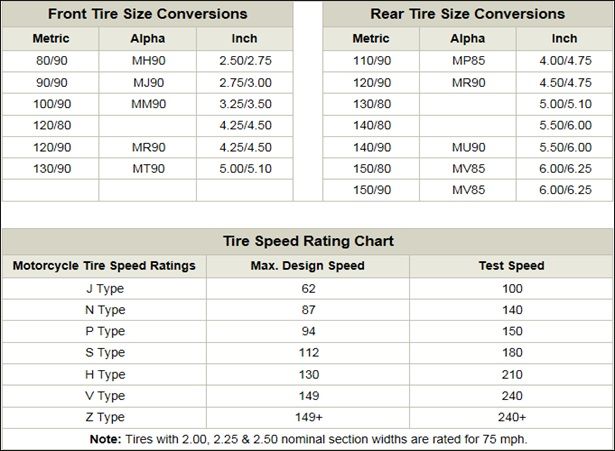 But they do so at a cost: most summer tires only work well at temperatures of about 40 degrees Fahrenheit and above. As outside temps fall toward freezing, the tires can feel skittish and behave inconsistently; they lose a large portion of their grip to the point that they act like they are on a wet or even icy road. More than one driver of a powerful car, unaware of the temperature sensitivity of its summer tires, has lost control and crashed on a cold day.
But they do so at a cost: most summer tires only work well at temperatures of about 40 degrees Fahrenheit and above. As outside temps fall toward freezing, the tires can feel skittish and behave inconsistently; they lose a large portion of their grip to the point that they act like they are on a wet or even icy road. More than one driver of a powerful car, unaware of the temperature sensitivity of its summer tires, has lost control and crashed on a cold day.
As with all-season tires, summer rubber comes in several varieties. Tire Rack divides these tires into three main groups by escalating capability: ultra-high performance on the bottom rung, followed max performance and extreme performance. Summer tires come on cars such as Porsches, Corvettes, Mercedes-AMGs, and Mustangs.
Winter Tires$183 at Amazon
Credit: Amazon$211 at Amazon
Credit: Amazon$469 at Amazon
Credit: AmazonCalled "snow tires" in the past, winter tires are designed to provide maximum traction in snow and in slippery winter conditions—and the traction they provide in those situations is not matched by any other category of tire. Even an all-wheel-drive vehicle on all-season tires cannot match the stopping or turning capability of a similar two-wheel drive vehicle fitted with four winter tires, a point we have proven in our own winter-tire testing.
Even an all-wheel-drive vehicle on all-season tires cannot match the stopping or turning capability of a similar two-wheel drive vehicle fitted with four winter tires, a point we have proven in our own winter-tire testing.
Winter tires are designed to work well in the cold-weather months, but they don't handle or wear as well as all-season or summer tires once the weather warms up. They should be considered as a second set of tires for your vehicle if you live where snow flies annually. We fit all of our long-term test vehicles with winter tires and they've proven their worth many times over.
Why use winter tires? If you live in the northern states, we recommend purchasing a set of winter tires. Their deep treads are engineered to deliver a significant traction improvement, and do they ever work. You'll feel safer and be safer, not to mention more relaxed when driving in snow. Retailers such as Tire Rack will sell you a set of snows mounted on steel wheels that you can swap on when winter rolls around. Here at Car and Driver, we swear by them.
Here at Car and Driver, we swear by them.
Tire Size and Other Factors
Most consumers choose to replace the worn tires on their vehicle with something equivalent in size and capability. This makes a lot of sense; your car was engineered to work well on the type and size of tires it came on, so fitting an identical or similar replacement set would maintain the performance and safety your vehicle was designed to deliver. (We'll get to upgrading later on).
To inform your decision process, you'll need to know your vehicle's tire size and speed rating, and you'll also want to consider how many miles you'll get out of any new tires you are considering (this is called tread wear). Much of that information is printed on the sidewalls of the tires that are on your car right now. It's also available in most owner's manuals, online, and at tire dealers. (We suggest cross-checking those sources to make sure you've got the right information.)
It's also available in most owner's manuals, online, and at tire dealers. (We suggest cross-checking those sources to make sure you've got the right information.)
Here's how to read the most important data imprinted on your tires' sidewalls. (For an in-depth look at how to read all of the information on a tire sidewall, click here.)
KEY: 1) Tire width; 2) Aspect ratio; 3) Radial-tire designation; 4) diameter; 5) Load rating with speed rating; 6) Heaviest spot on tire; 7) Tread-wear rating; 8-9) Traction and temperature ratings; 10-11) Mud-and-snow or three-peak-mountain rating; 12) Vehicle-specific marking; 13) Tire-materials list and manufacturing information
Tire SizeIf you're going to replace your tires with something equivalent, you will need to know the proper size. The size of car and light truck tires is usually expressed in a short series of numbers and letters that read like this (as seen in the above illustration): 245/40-R18.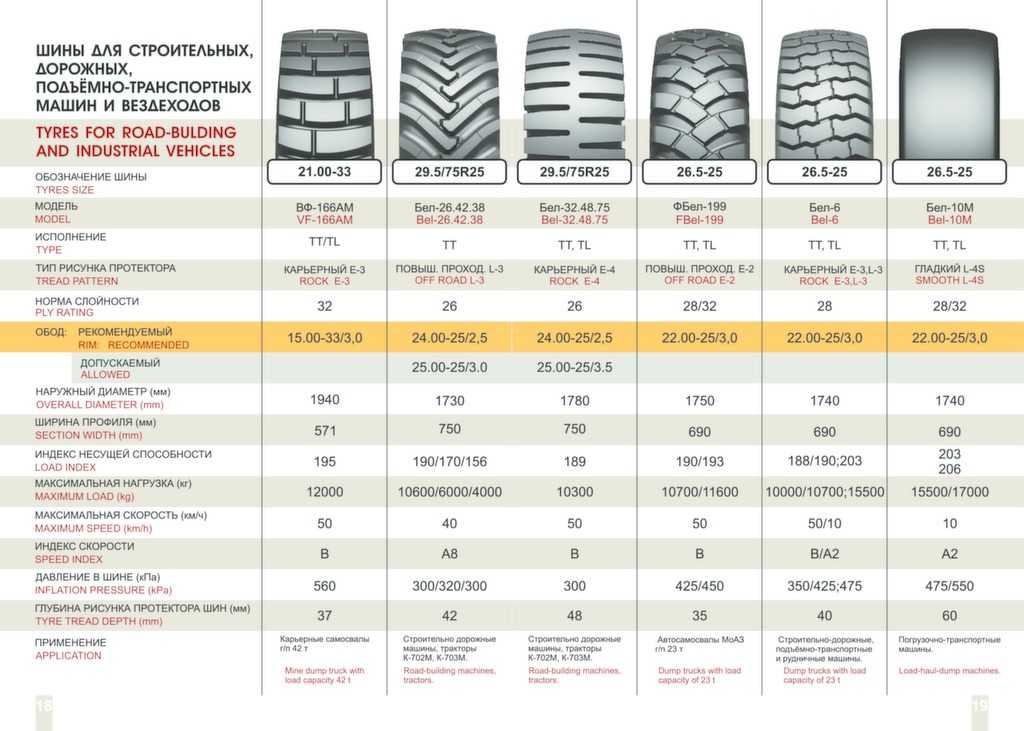 The first number indicates the width of the tire at its widest point in millimeters. The number after the slash is what's called the aspect ratio, which indicates how tall the sidewall is as a percentage of the width. The higher the number, the taller the sidewall. The squat tires fitted to sports cars and muscle cars, called low-profile tires, have aspect ratios of 30–40. Family sedans and SUVs are in the 45-60 range or taller. The final number in the series is the diameter of the wheel in inches that the tire must mount to. The "R" indicates it's a radial tire, which virtually all of today's tires are.
The first number indicates the width of the tire at its widest point in millimeters. The number after the slash is what's called the aspect ratio, which indicates how tall the sidewall is as a percentage of the width. The higher the number, the taller the sidewall. The squat tires fitted to sports cars and muscle cars, called low-profile tires, have aspect ratios of 30–40. Family sedans and SUVs are in the 45-60 range or taller. The final number in the series is the diameter of the wheel in inches that the tire must mount to. The "R" indicates it's a radial tire, which virtually all of today's tires are.
Tires also carry a speed rating, which indicates not only how fast they can safely go for an extended period of time, but also the overall performance potential of the tires. Tires for high-performance cars have a higher speed rating than those for mainstream family sedans and SUVs. The speed rating of the original tires that came on your car were matched to the maximum speed the car could attain—plus a significant built-in safety margin. This speed rating is expressed as a letter in the alpha-numeric code that immediately follows the tire size. Letters range from L to Y, and cover maximum speed ranges from 75 mph to more than 186 mph.
This speed rating is expressed as a letter in the alpha-numeric code that immediately follows the tire size. Letters range from L to Y, and cover maximum speed ranges from 75 mph to more than 186 mph.
The are two pieces of data that will help you estimate how many miles you can expect from a set of tires: the tread-wear rating and the tire mileage warranty. The tread wear rating is listed as a number on the tire sidewall after the word "treadwear". The higher this number, the more likely the tire will last longer. But the tests that are used to determine treadwear aren't precise, so there is a lot of variability in this number.
A better way to gauge potential tire life, and to compare the expected longevity of different tires you might be considering, is to look at the manufacturers' tread-life warranties. Many but not all tires carry a tread-life warranty in addition to manufacturing-quality/defect warranties. This information can be found online (like this example from tirerack.com), or in the tire maker's marketing materials. The industry's general rule is that about three-quarters of all drivers will find that their tires last at least last as long as the mileage listed in the tread life warranty. Generally, if your tires wear out before the guaranteed mileage bogey, you can get a credit for the percentage of miles you came up short, which you can then apply to the purchase of a new tire. (Tire dealers routinely handle this transaction.)
This information can be found online (like this example from tirerack.com), or in the tire maker's marketing materials. The industry's general rule is that about three-quarters of all drivers will find that their tires last at least last as long as the mileage listed in the tread life warranty. Generally, if your tires wear out before the guaranteed mileage bogey, you can get a credit for the percentage of miles you came up short, which you can then apply to the purchase of a new tire. (Tire dealers routinely handle this transaction.)
Numerous automakers fit their cars with run-flat tires from the factory. These tires are capable of driving for short distances at low speeds even after a puncture has left them without air, allowing you to reach home or a repair facility without needing to change a flat on the side of the road. If your vehicle came on run-flats you have the option of replacing them with conventional tires and carrying a spare (but beware that some cars fitted with run-flats actually do not have a trunk compartment for a spare). Or, you can replace your worn run-flats with another set of run-flats. And now that tire-pressure monitoring systems are compulsory equipment in new cars, you could even fit run-flats on a car that didn’t originally come with them.
Or, you can replace your worn run-flats with another set of run-flats. And now that tire-pressure monitoring systems are compulsory equipment in new cars, you could even fit run-flats on a car that didn’t originally come with them.
Run-flat tires do have downsides. Their stiff sidewalls, which are required to hold the tire up when deflated, tend to make the car ride noticeably harder over rough pavement, but tire tech is continually improving and run-flats aren’t nearly the penalty they were a decade ago. Choice is also more limited than with conventional tires and run-flats are premium-priced. In general, we'd recommend swapping to conventional tires and carrying a spare or mini-spare if possible.
There's one more decision you need to make: do you simply replace the tires on your vehicle with something equivalent, or upgrade?
If you're going to replace what came on the car with something equivalent, you're ready to go. Peruse the online resources like Tire Rack to compare tires, and then either buy from one of them or head to a local tire store. The advantage of buying online is that you can get the exact tires you want; different brick-and-mortar tire stores sell different brands of tires. The online retailers have relationships with the chain tire stores, which will mount the tires you bought on the internet on your wheels (for a small fee) even though you didn't buy them there. Tire Rack has a decision guide to help you find the tires that fit your car.
Peruse the online resources like Tire Rack to compare tires, and then either buy from one of them or head to a local tire store. The advantage of buying online is that you can get the exact tires you want; different brick-and-mortar tire stores sell different brands of tires. The online retailers have relationships with the chain tire stores, which will mount the tires you bought on the internet on your wheels (for a small fee) even though you didn't buy them there. Tire Rack has a decision guide to help you find the tires that fit your car.
This is more complicated than simply replacing your tires, as you have several ways to go. You can choose a higher-performance tire of the same size on your current set of wheels by substituting, say, a high-performance all-season tire for a standard all-season—if you can find one that fits exactly. Or you can choose a set of wider, lower-profile summer or high-performance all-season tires, but this is trickier. You need to know if the tires will fit without rubbing on the suspension or body parts—a definite safety issue. Here, consulting one of the experts at Tire Rack is a must, as they have this information for many cars. You can also try checking an online forum for your make and model of car (if one exists).
You need to know if the tires will fit without rubbing on the suspension or body parts—a definite safety issue. Here, consulting one of the experts at Tire Rack is a must, as they have this information for many cars. You can also try checking an online forum for your make and model of car (if one exists).
Many vehicles can be had from the factory with several different tire sizes—Honda Civics, for example, come with tires ranging from 215/55-R16 to 245/30ZR-20—so going to a larger-diameter wheel might work. But know that fitting lower-profile rubber will almost always require a larger-diameter wheel. The outside diameter of your tires needs to remain constant; everything from your vehicle's suspension to its ground clearance to its gearing is affected by the overall size of the tires. As the sidewall gets slimmer, the wheel must grow to compensate. Use this size guide to see how switching to a lower-profile tire affects wheel diameter.
Wider, lower-profile higher-performance tires can also make the car ride rougher, wear faster, be noisier, and influence the steering, possibly causing you to have to make more steering corrections on the Interstate.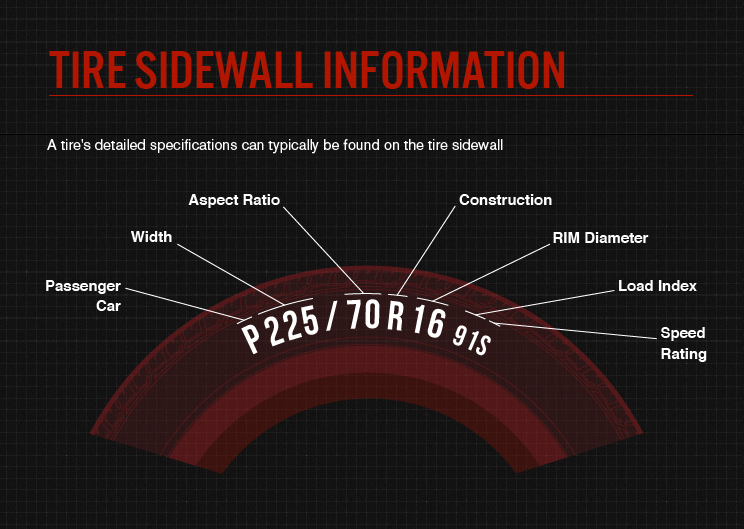 Low-profile tires will also probably be more prone to damage from potholes, something we experienced with one of our long-term cars, which blew out a dozen of its low-profile tires in the course of 40,000 miles on our rutted Michigan roads. And they'll almost definitely be more expensive, plus you'll have to buy a new set of wheels. You'll need to consider all of these issues carefully before you make the leap.
Low-profile tires will also probably be more prone to damage from potholes, something we experienced with one of our long-term cars, which blew out a dozen of its low-profile tires in the course of 40,000 miles on our rutted Michigan roads. And they'll almost definitely be more expensive, plus you'll have to buy a new set of wheels. You'll need to consider all of these issues carefully before you make the leap.
For everything you need to know about buying and maintaining tires, click here.
A tire’s speed rating indicates the optimal speed that the tire can safely maintain over time. In short, it’s the fastest speed a tire can handle before it no longer performs as designed. The higher the speed rating, the better control and handling you’ll have at higher speeds.
The speed rating system was developed to help control the safe performance of tires at standardized speeds.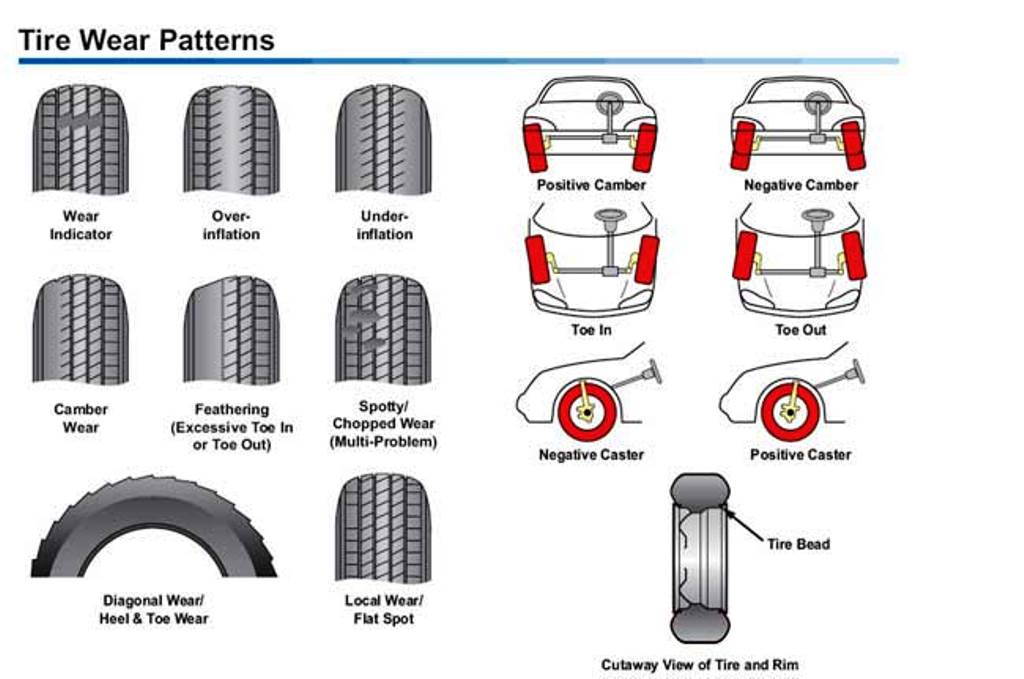 A tire’s certified speed rating is given a letter from A to Z, ranging from 5km/h (3mph) to above 300 km/h (186 mph).
A tire’s certified speed rating is given a letter from A to Z, ranging from 5km/h (3mph) to above 300 km/h (186 mph).
This rating system (see below) shows the top speed for which a tire is certified. It does not indicate the total performance capability of a tire.
The speed rating system used today was developed in Europe in response to the need to control the safe performance of tires at standardized speeds. When the rating system was originally developed, the "Unlimited V" category of over 210 km/h (130 mph) was the top speed rating possible.
As manufacturers developed bigger and better tires, it became necessary to regulate performance at standardized speeds to ensure safety. The "Limited V" category of 250 km/h (149 mph) was then created, and eventually the "Z" speed rating was added as the top speed rating. (Always consult the manufacturer for the maximum speed of Unlimited Z tires.)
You can find your tire speed rating in a number of places, typically in the owner’s manual, driver’s side doorjamb, glove box door, and gas tank hatch.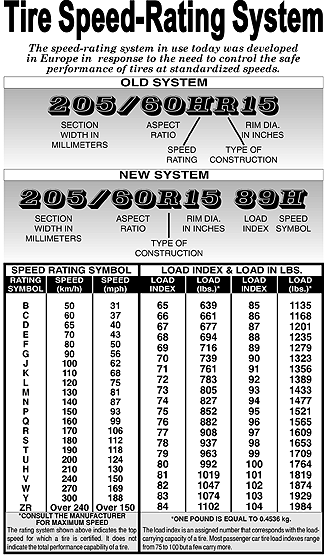 Recent standardization has changed so all ratings except "Unlimited ZR" incorporate the speed symbol and load index as part of every tire’s service description on the tire’s sidewall. If you’re reading your tire sidewall, the speed rating will be the last item in the character sequence in the tire’s size code. Below is an example of a the description on a tire’s sidewall: 2015/60R15 91V. Here, the tire would have a speed rating of V. V-rated tires can be driven at 149 MPH.
Recent standardization has changed so all ratings except "Unlimited ZR" incorporate the speed symbol and load index as part of every tire’s service description on the tire’s sidewall. If you’re reading your tire sidewall, the speed rating will be the last item in the character sequence in the tire’s size code. Below is an example of a the description on a tire’s sidewall: 2015/60R15 91V. Here, the tire would have a speed rating of V. V-rated tires can be driven at 149 MPH.
TIRE DESCRIPTION
| 205/60R15 91V | |
|---|---|
| 205 = Section Width in Millimeters | |
| 60 = Aspect Ration | |
| R = Radial Construction | |
| 15 = Rim diameter in Inches | |
| 91 = Load Index | Service Description |
| V = Speed Symbol | |
Tires having a maximum speed capability over 149 MPH may have “ZR” in the size designation.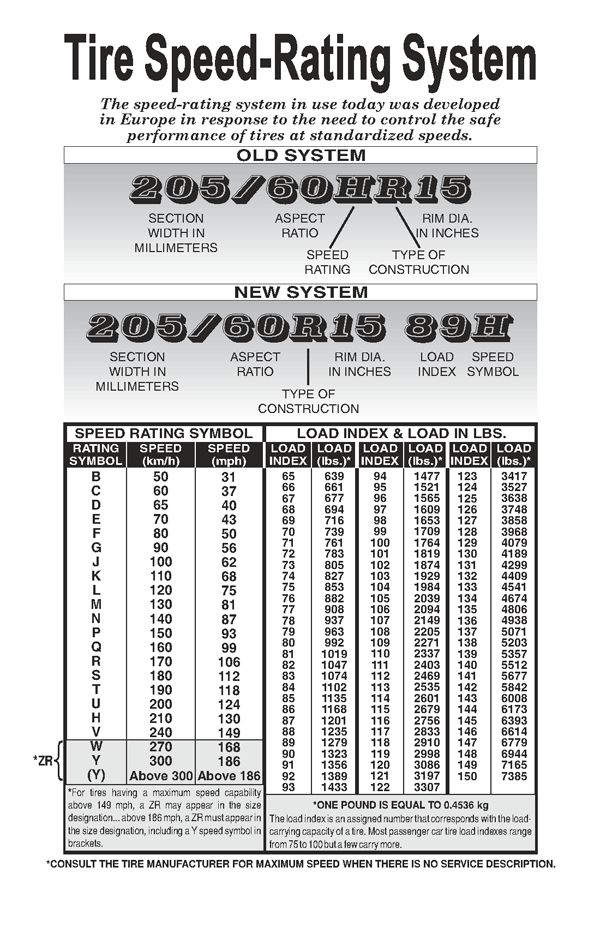 Tires with a maximum speed capability over 186 MPH are required to include “ZR” in the designation. Below are examples of tire sizes with a “ZR” speed rating.
Tires with a maximum speed capability over 186 MPH are required to include “ZR” in the designation. Below are examples of tire sizes with a “ZR” speed rating.
ZR DESIGNATION
| EXAMPLES | |
|---|---|
| Tire Designation | Maximum Speed |
| P275/40ZR17 93W | 270 km/h (168 mph) |
| P275/40ZR17 93Y | 300 km/h (186 mph) |
For tires with a maximum speed capability higher than 240 km/h (149 mph), a "ZR" may appear in the size designation. Tires with a maximum speed capability higher than 300 km/h (186 mph), require a "ZR" in the size designation. Consult the tire manufacturer for maximum speed when there is no service description.
TIRE SPEED CAPABILITIES
| SPEED SYMBOLS | ||
|---|---|---|
| Symbol Speed | Speed (km/h) | Speed (mph) |
| A1 | 5 | 3 |
| A2 | 10 | 6 |
| A3 | 15 | 9 |
| A4 | 20 | 12 |
| A5 | 25 | 16 |
| A6 | 30 | 19 |
| A8 | 40 | 25 |
| B | 50 | 31 |
| C | 60 | 37 |
| D | 65 | 40 |
| E | 70 | 43 |
| F | 80 | 50 |
| G | 90 | 56 |
| J | 100 | 62 |
| K | 110 | 68 |
| L | 120 | 75 |
| M | 130 | 81 |
| N | 140 | 87 |
| P | 150 | 94 |
| Q | 160 | 100 |
| R | 170 | 106 |
| S | 180 | 112 |
| T | 190 | 118 |
| U | 200 | 124 |
| H | 210 | 130 |
| V | 240 | 149 |
| W | 270 | 168 |
| Y | 300 | 186 |
Need help understanding the speed rating on tires? Our technicians have got you covered.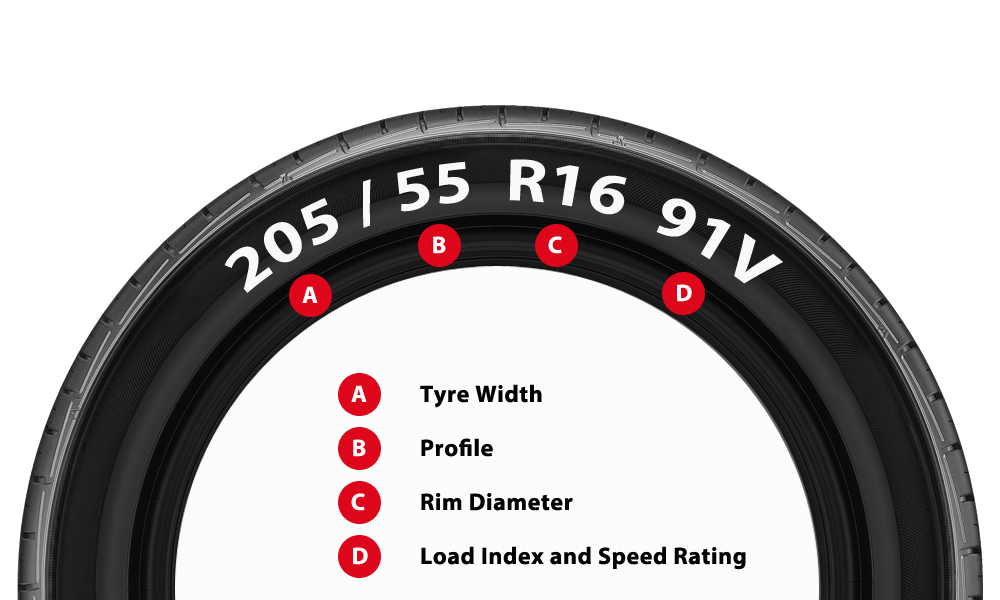 Bring your vehicle by your local Tires Plus and we’ll help you understand your tire numbers, tire size, and more!
Bring your vehicle by your local Tires Plus and we’ll help you understand your tire numbers, tire size, and more!
{{storeNumber}}
{{storeName}}
{{link-icon "Call Us" mobileCallLink null "call-cta"}} {{link-icon "Directions" directions "_blank" "directions-cta"}}
{{address}}
{{city}}, {{state}} {{zip}}
{{#if activeFlag}} {{#ifCond mystore "or" myPreferredStore}} {{#ifCond storeType 'eq' "TPL"}}
*Call store for appointment {{phone}}
{{else}} {{#if onlineAppointmentActiveFlag }}
{{#if myPreferredStore}}
{{else}}
*Call store for appointment {{phone}}
{{/if}} {{/ifCond}} {{else}} {{#ifCond storeType 'eq' "TPL"}}
*Call store for appointment {{phone}}
{{else}}
Schedule Appointment {{#if onlineAppointmentActiveFlag}} {{else}}
*Call store for appointment {{phone}}
{{/if}}
{{/ifCond}} {{/ifCond}} {{else}}
*Temporarily Closed Due To: {{temporarilyClosedReason}}
{{/if}} {{#if isMilitaryStore}}
*This location is on an active US military base. You may need military ID to access the location.
You may need military ID to access the location.
{{/if}}
In fact, the average life of any tire is 5-7 years, but a lot depends on how the owner treats his car. Aggressive driving, improper seasonal tire storage, unrepaired suspension/balancing problems, incorrect pressure and other errors can significantly shorten tire life. But worn tires can be a serious problem on the road: an increased risk of uncontrolled skidding, hydroplaning, even accidents is the price that drivers and passengers have to pay for using old tires. nine0003
Each manufacturer indicates the so-called wear index on the tire profile, which most often looks like the inscription “Treadwear 100” and means a maximum of 48,000 km on a standard road surface (polygon). In a real environment and often not the most ideal roads, this number actually needs to be divided by 1. 5 - we get 36,000 km.
5 - we get 36,000 km.
By analogy, if the wear resistance index is 150, then this means “factory” 72 thousand km, 200 - 96 thousand km., and so on.
What are the dangers of worn tires on the road:
adhesion to the roadway deteriorates, which leads to an increased likelihood of skidding, accidents, hydroplaning in case of rainy weather;
reduced cross-country ability in off-road conditions;
increases the risk of a tire puncture while driving. nine0003
It is also worth remembering that the issue of tire wear is regulated by traffic rules, and you can get a fine for using “bald” rubber. Knowing what maximum tire wear is acceptable, this is easy to avoid: 1.5-2 mm for summer, and 4-5 mm for winter (a more accurate figure is indicated by the manufacturer).
1. According to the wear indicator on the tire. To find this indicator, you need to inspect the side of the tire and find one of the markings: a triangle, a company logo, a snowflake, or the abbreviation TWI.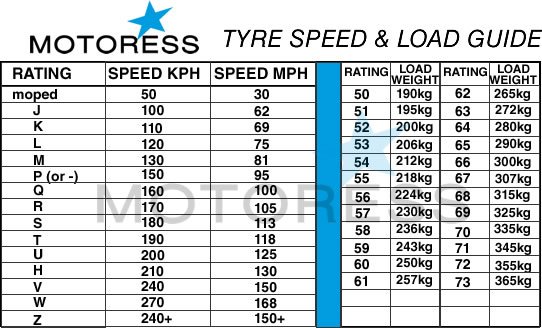 If the tread has worn down to this indicator, it means that the tire needs to be disposed of urgently. nine0003
If the tread has worn down to this indicator, it means that the tire needs to be disposed of urgently. nine0003
2. Many people in the old fashioned way prefer to use a 10-kopeck coin. Insert it into the tread with the inscription "10 kopecks" towards you, and if it is visible, the wear level is too high, you need to replace the tire. This method is convenient, but not entirely accurate: by measuring wear in different parts of the tire in this way, it will be difficult to estimate its unevenness by eye, and this is also an extremely important indicator.
3. It is optimal to use a special gauge, depth ruler or caliper for these purposes. This will allow you to measure the wear of the tread in different parts of the tire with an accuracy of up to a millimeter and understand if there is uneven wear. nine0003
If measurements show different results in different parts of the tread, it is important to determine exactly how your tires wear in order to understand where and what the operating error is.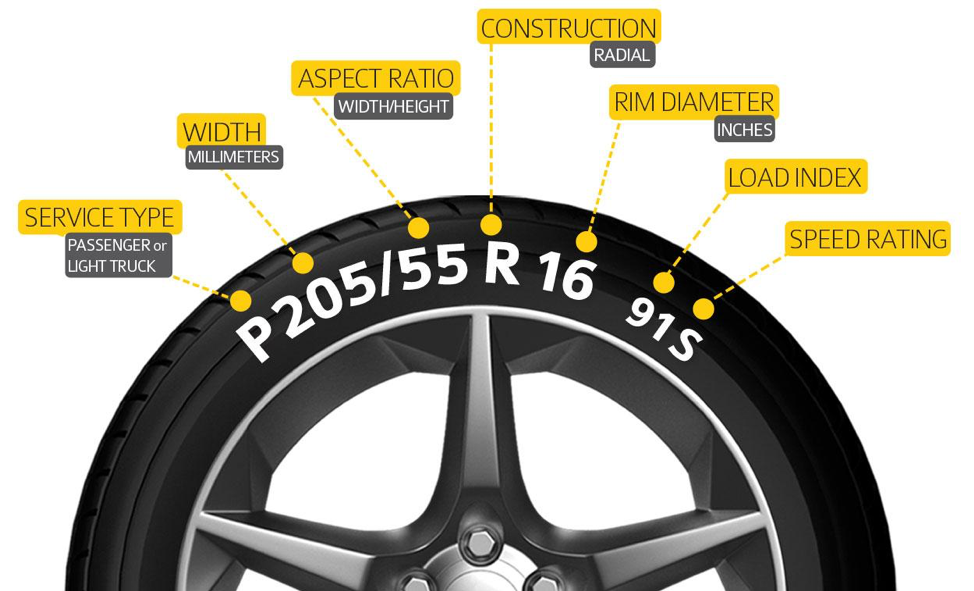
If the tread wears more on the sides and the center wears off less, this means that the tire pressure is insufficient and the contact patch with the road is not correct. This leads not only to poor vehicle stability, but also to increased fuel consumption. nine0003
If the tread is worn down the middle but the sidewalls are fine, then your tires are overinflated. Sometimes this is done intentionally in order to save fuel, but in this case, the tires will still have to be changed ahead of schedule.
There is also the possibility of increased wear on the inside or outside of the tread - this indicates an incorrect camber. A visual table with wear options and their causes:
Cracks on the sides of tires can indicate frequent off-road driving, improper storage, low-quality rubber or long service life, as well as incorrect tire pressure.
Bulges or "hernias" on the sides of the tires appear as a result of the side part hitting hard obstacles.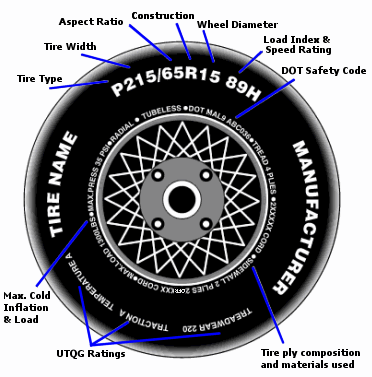 Tires with such damage are not recommended. nine0003
Tires with such damage are not recommended. nine0003
Dents on the tread indicate insufficient depreciation and unadjusted camber. Having found such damage, it is necessary to drive the car to the service and make sure that the suspension is in good condition.
Individual wear spots on the tread indicate aggressive driving / braking, skidding with wheel locks, or prolonged parking of the car in one position. nine0003
Most often, this is required for the sale and purchase of used tires in order to orient the buyer in the degree of their wear. Many sellers give this figure at random, but this method has nothing to do with the actual assessment of the degree of tire wear. It is also important to understand that a conditional 50% wear for a summer tire is an acceptable value, while 50% wear of a winter tire tread is a sign that the tire cannot be used. Therefore, it is important to know how to accurately determine the percentage of tire wear so as not to get into an unpleasant situation. nine0003
Many people divide the actual tread height by the height of the same, but new tire, and get a certain percentage of wear. This would be correct, if not for one BUT: we cannot physically erase the tread to zero, and the law prohibits the use of tires with a tread below the permitted values.
You can calculate actual tire wear by dividing the difference between the new tire height and the actual tire height by the difference between the new tire tread height and the minimum possible tread height for that tire, and then multiplying this number by 100. nine0003
If it is impossible to find out the height of the same, but with a new tire, use the average values of your tire type:
| Tire type | Average tread height at start of use |
| Winter tires with Scandinavian tread | 10 mm nine0003 |
| Winter with regular or asymmetric tread | 9 mm |
| High-speed winter | 7 mm |
| Summer tires with classic tread nine0085 | 8 mm |
| Summer speed | 7 mm |
You can check summer tires for wear a little less often than winter tires, since in summer the tread depth is not so important for patency.
If you have assessed the condition of your tires on all of the above factors and realized that the tires are worn out, be sure to replace them with new ones as soon as possible. nine0003
Before the next winter, motorists who have driven for several seasons on studded or friction tires have a question. Should I buy new ones or old ones are still able to provide reliable grip on snow and ice? To make the right decision, you need to know how to determine the wear of winter tires, and what is its maximum allowable limit.
The main indicator of the suitability of tires for operation is the tread height. However, in the case of studded tires, the number of studs is an equally important factor. Even when there are almost none left, some motorists are in no hurry to get a new thing. Such drivers mistakenly think that in this way their tires have become frictional. nine0003
But tires, which are popularly called Velcro, have a completely different rubber compound.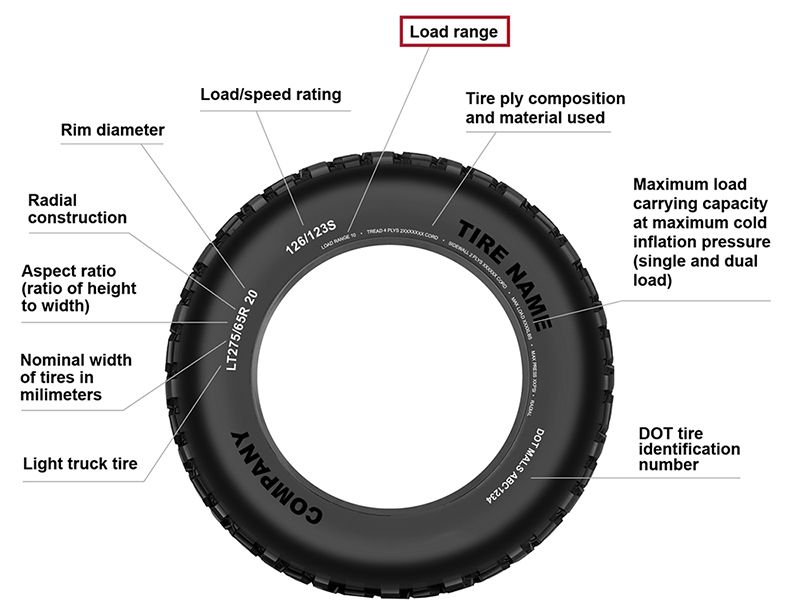 They are much softer than studded ones and lose their valuable properties faster in the cold.
They are much softer than studded ones and lose their valuable properties faster in the cold.
Winter tire wear is estimated according to the following indicators:
The "List of malfunctions and conditions under which the operation of vehicles is prohibited" establishes a critical tread wear of a winter tire - 0.4 cm. But most manufacturers of studded and friction tires recommend changing earlier. To measure the tread height, a regular ruler will do. If the result is 0.5 cm, it is better to purchase new tires.
It is necessary to measure the tread height not in one place, but in several, since wear can be uneven. For example, 0.6 cm may remain on one side of the tire, and 0.4 cm on the other. In this case, it is necessary to change the tires. You can buy winter tires at the TopDetal.